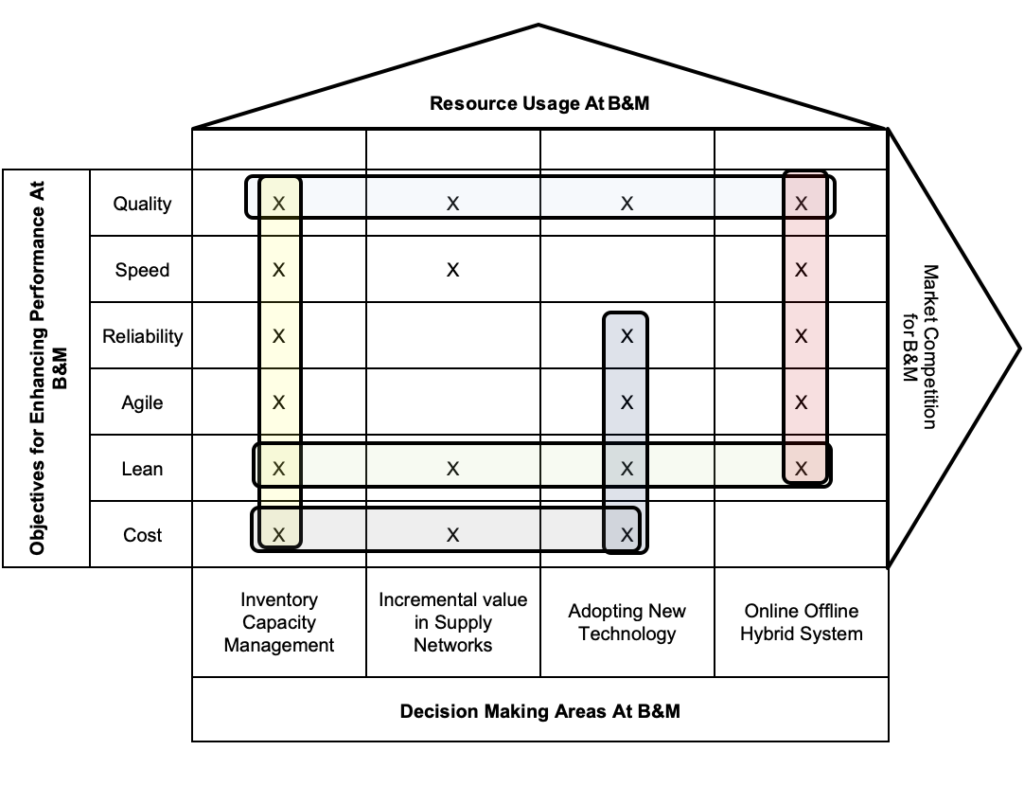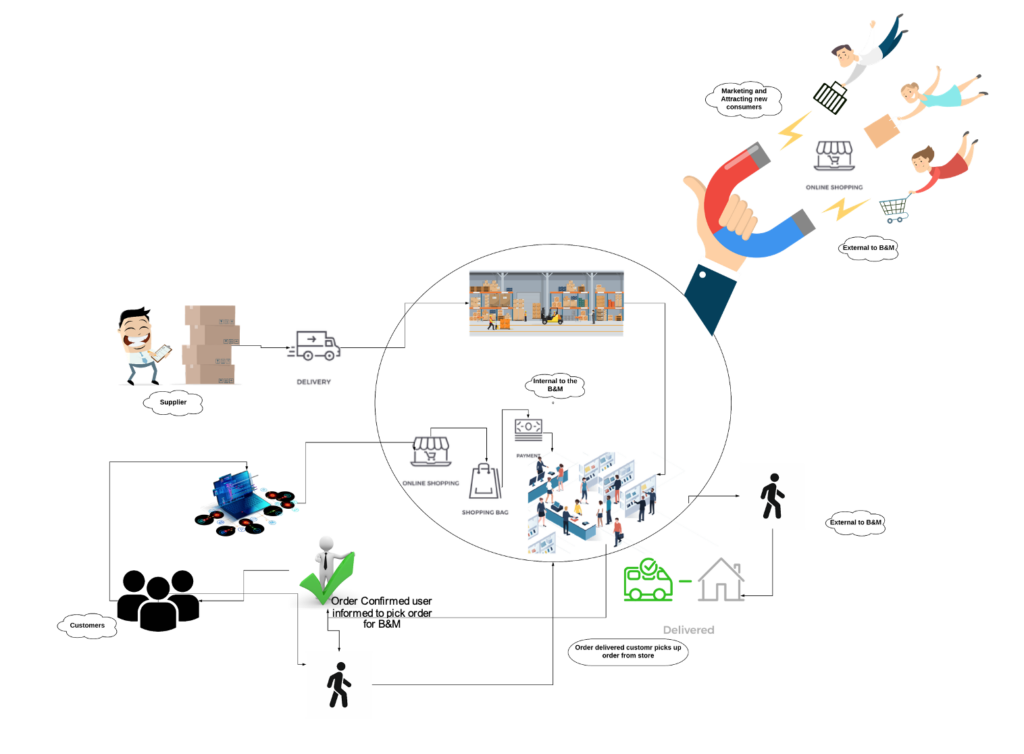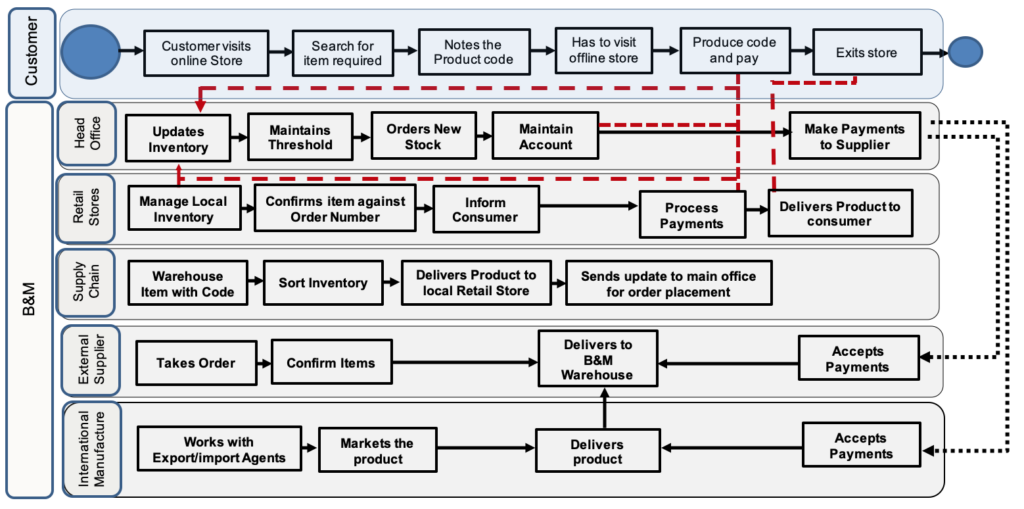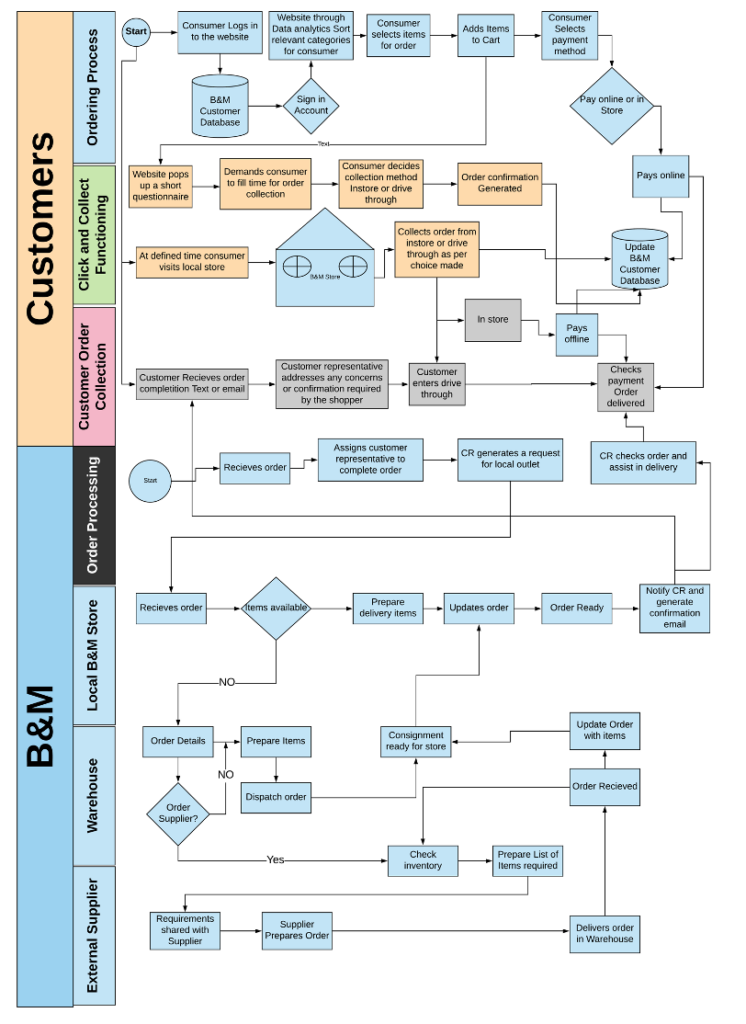PART – A
1.1 Introduction to the Company
B&M is one of the world’s leading retail organizations. Its purpose of existence is to offer consumer high end services meeting their intimate demand. It highly focuses on the parameters to empathies with consumer. The organization has learnt to offer homely and enabling environments fully embedded in its culture to encourage their staff to support the people they care for. Organization aims to become epitome of excellence incorporating ethical values across its eco-system. B&M owns 600 stores and employ around 28,000 individuals worldwide.
The organization has achieved exceptional growth by remaining true to its purpose. However, according to Christensen, Bartman, and Van Bever (2016) there are many disruptive forces in external environment, retail is also experiencing the change hence B&M has to organize is operations to proactively respond to external forces like changing consumer behavior and technology.
1.2 B&M Operational Strategy
The consumer behavior is changing and shifting more towards online purchasing. The rise in millennial’s population has necessitated for the organization to move its operations online. The operational Strategy will discuss various parameters to accentuate in order to deliver a successful operational model.
1.2.1 Value Preposition in B&M operational Strategy
The key value preposition in the B&M operating model is high level of focus on low cost, good quality, exceptionally wide variety, and immaculate customer services (Hsu & Tsaih, 2016). The company understands the real need of consumers and is fully organized to capture the value. There is a strong understanding within organization that their hybrid strategy is fully supportive of key trends. Nevertheless, organization continuously makes effort to determine changes in the external environment to transform is products so that company remains consistent with the needs of the users. This dedicated sourcing technique is maintaining relevance on regular basis. Furthermore, the organization adopts concepts of lean methodology (Martins, Amorim, & Almada-Lobo, 2018). B&M adopts just in time approach to maintain stock levels without adhering to high storage cost. The firm is able to organize around the consumer needs, it refreshes stocks level if demand forecasts indicates otherwise retail store doesn’t remain attached to any product emotionally. The decisions range from discontinuing product line or develop on products to gain learning to adopt to market scenario.
1.2.2 Operation Strategy Performance (priorities) Model

To adopt a hybrid system there has to be a system of integrated services, the key operational mix has to focus on the 6 key performance standards as shown in the image above. Moreover, in the hybrid system cost is not a concern however, quality, speed, reliability, agile, and lean are critical factors to ensure the organization can create a hybrid system (Huang, Pan, & Liu, 2017).
1.2.3 Value Creation
Value creation can be best explained using Walter’s four V’s profile:
- Volume – Being one of the largest retail stores in the United Kingdom, the volume of service provided is immense, as the sheer magnitude of customers served each week is immense. This scale of output in product sales demonstrates a systematic approach in assuring quality to all clients.
- Variety – B&M does not simply restrict itself to the retail of one particular class of goods, rather its offerings encompass a broad spectrum. The company offers groceries, home appliances, outdoor equipment, leisure goods and so much more
- Variation – Each store in every location has a unique blend to it, with special discounts offered on unique items, given the time and season of the year, as opposed to a ‘one size fits all’ standardized service.
- Visibility – Customers can easily view the items they are making a purchase for, and the price and other information regarding it.
1.3 Soft System Methodology
As cited by Schary (2017) Soft System Methodology is a dynamic mechanism the empowers the decisionmakers to fully define the problem and endeavor to determine a solution. The key parameter of the Soft System Methodology is that it has the ability to breakdown the complex problem into meaningful smaller pieces which can be evaluated as standalone or in an integrated system to determine their causal relationship. As designed by Lane and Oliva (1998) this methodology enables step by step analysis of a system to determine an effective solution.
1.3.1 Problem Situation for B&M
Kahn, Inman, and Verhoef (2018) claims that retail landscape has changed a lot and is still changing due to multifaceted external factors. Most dominant of all is online purchasing by consumers. Now the business case of online is challenging sustainability of offline alone model. Hence it can be stated that biggest threat faced by B&M is lack of online presence. This is a problem because now consumers are buying right from the comforts of their mobile phones without having to actually travel for purchasing. Latest Statistics shows that out of every 10 people 9 people have reliable access to internet in their homes. Hence, this is more of a compelling reason to have access over internet for user to see B&M as their service provider. The established loyal consumer would shrink, and future is necessitating to adopt towards millennials and eventually generation Z.
1.3.2 Problems of Hybrid Model
Developing on the previous problem another related obstacle noted is that B&M does not have an online business model. This limitation hinders in adoption of new processes as current policies governing the management framework do not have the mechanism to promote change and innovation within organization. Moreover, Sheer size of the business also inhibits to readily adopt new model. The competitors of B&M are already using the new methodologies and existing models such as WILKO demonstrate a centralized system being followed which allows for fast decision making from the top and efficient flows of information from top to bottom which is shown to be followed. Moreover, Tesco moved online and has reap many benefits they are currently leading the online marketplace in terms of volumes and revenues. Hence, going online is critical for business sustainability and continued competitive advantage.
1.4 Goals for New Business Model
1.4.1 Customer Value Model
B&M is highly consumer centric hence their online model must be fully configured to deliver increasing value to consumers. B&M top management calculates the worth of each customer over their entire life. Furthermore, to map consumer behavior B&M must have means to collect and record data regarding demographics and spending on daily basis. Using the data B&M new model can segment consumers in a precise manner.
1.4.2 Service gap model
Since B&M excels in providing exceptional customer services to its clients offline hence the similar has to transformed towards online. Nevertheless, the employees highly skilled in offline customer service would require to be trained on online model to deliver higher value and similar personalized experience online.
1.5 Existing Models
1.5.1 Centralized
Clipper logistics is the organization that offer services to Wilko to manage their operations. They manage things in a centralize manner as they have a specialized centrally control unit Ollerton e-fulfillment which extends from 110,000 sq. ft. to 150,000 sq. ft. The facility has the space to harness 14000 product lines and 400,000 individual units this allows them to effectively deliver the products in a controlled environment.
1.5.2 Decentralized
Argos and Sainsbury UK offer in store pick up as they offer a more decentralized approach for the customer to decide on their best course of services they need. More people want the flexibility to have the ability to schedule an order pick from the local store as they can receive it at their own pace and time. Argos involve their own fleet rather than relying on a service provider this way they can offer the consumer the flexibility to pick in store or get it delivered the same day (Post and Parcel, 2015). They have a decentralized operations management where manager can take effective decision in line with the best interest of the organization. The organization has an electronic one view warehouse as they can immediately confirm if the order is available or not reducing the customer wait time.
1.5 Proposed Model for E-commerce: The Possible Solution
The Dark Store Model is not suited for B&M since they cannot abandon their offline stores as they still offer consumers a higher value (Badgett, 2018). One more factor to be considered is parcel conundrum, a term referring to delivery failures due to absence of receivers. The statistics guide that cost of delivery can increase by 15% to the order price rendering the system very expensive to manage or operate. Hence it is not advisable for B&M to fully adopt online model for delivery of services as it will increase the cost and might negatively disrupt the change towards dominating e-commerce. Hence it is recommended to adopt click-and-collect model. This will provide enough flexibility to the consumers to ensure they can effectively make order saving a lot time. Moreover, click and collect will be merged with the existing system of brick and mortar model (Dolfen et al., 2019).
The reason B&M would require a hybrid model to conduct their operations is that increasing digitization and online systems such as delivery to customers at their homes is becoming essential (Lim, Jin, & Srai, 2018). However, going fully home delivery service can increase the cost of the process to a great degree negatively impacting the competitive advantage negatively. Given the extremely competitive nature of this industry, it is essential the B&M to embrace this change and use all its resources to innovate towards perfecting this model.
The new business model would lower the pressure on physical locations and staff. It would make sense for B&M to adopt the hybrid model to continue conducting its operations for the future if it truly wants to achieve financial viability that is sustainable in the long-term future and wants to maintain its competitive position it in the market it currently is holding.
PART B: Rich Picture
2.1 Detailed Picture

2.2 Root Definition
Root definition is a concept that is very useful to companies especially with regards to operations management. It falls within the broader SSM, which stands for soft systems methodology (Pereira, Montevechi, Miranda, & Friend, 2015).
Precisely put, A root definition is any such statement which can manage to concisely describe any given system of interest, which is predominantly not more than a single sentence proceeding the phrase “a system to is to be designed that harnesses power of online and offline as a whole”
It is essential the root definition does not leave out any core elements of the system which would cause confusion as to precisely what the system manages to accomplish once in place. As shown in the rich picture, the external environment of the business is changing and going online is simply not the most sustainable option in all scenarios. The operating cost increases due to return of good as consumer is not available to receive them. The rich picture demonstrates that without going online the system cannot ensure effective consumer sourcing. They cannot effectively retain the consumer base nor can grow. Hence in order to grow the consumer base online option is most practical approach. In order to reduce the operational cost, the B&M can implement in store collection system where consumers will have due convenience and also the brand will be able offer effective value. Rich picture explains the consumer can order online walk in store. Warehouse and inventory will be connected to a database to ensure each department can effectively check order availability. This will ensure the system will be quick in order processing and wait time for inventory will reduce increasing the efficiency.
2.3 CATWOE
CATWOE is merely a practical extension of the concept of the root definition idea, which attempts to mention all core elements related to the system being described. According to Mo and Cook (2018) given that the definition can take several forms, there are different ways to ensure all appropriate and relevant elements are included, and CATWOE is simply a mnemonic device employed by operational managers to ensure consistency and feasibility of root definition.
C – Customer – The concept includes current and potential consumers willing to procure B&M services. It is agreed they have a large consumer base offline however when B&M will be going online they will be expanding the potential consumer base. Like click and collect model for online management will interest many consumers who want to save time by ordering online. Having presence in both types of service models can allow B&M to personalize its services according to the needs of each customer.
A – Actors – Actors are the task executors who are employees at all levels and departments. Since, there is a whole new mode of integrated business processes is being included under their umbrella of operations. In this case, it has to be ensured that employees are adequately trained and are given demo to understand how they have to execute each task with the efficiency of lean processing. Hence, the focus is that business doesn’t create waste.
T – Transformation – The existing system of offline retailing is changing, and people are going to engage with the brand with a service quality perception, which is very good in the minds of consumers. Since transformation of how consumers can interact with the B&M is changing so should policies and procedures. In case of click and collect, how an employee will prioritize services rendering amongst online and offline employees. This process must be transformed alongside to ensure everything is in place to achieve better outcome.
W – Worldview – The world’s view regarding B&M is based on low cost, good quality, durability, and exceptional variety. Hence, when an online channel is introduced this should be done so to further enhance value deliverance towards customer’s end. Through online model B&M will be reducing many operating expenses hence they would be more optimized and could offer more value to the consumer.
O – Owners – B&M is a publicly listed firm which shows that its ownership is shared by a group of public shareholders. Since, online processes are also being solely introduced by the management of B&M hence in this case the organization will have complete ownership of the assets and processes. This implies that all strategic decision making is directly being done by management considering the wishes of the shareholders. Hence it can be concluded that management has full control over processes to make changes that were deemed necessary.
E – Environment – The ecosystem demands B&M to be environmentally and socially responsible. The online system is an effort towards green achievements. The organization is making effort to reduce emissions by having consumers to specially drive for B&M. With current click and collect system the consumers can order and collect when they are passing by the store hence extra gasoline is not burnt. Moreover, B&M is making effort that their energy sources come from sustainable renewable sources. The introduction of this new processing mode will reduce logistics needs by B&M to send a courier to deliver the order neither will consumer have to specially come to store. Consumer arrive at stores according their ease and comfort. Hence reducing their number of visits.
2.4 Business Process Plan
The executive management of B&M decides to formulate a Business Process Plan to map its current state and to be state so that gap can be analyzed to make effective changes in process system (Page, 2015). In order to do that, two key questions needed to be asked are: What is the current state of affairs? What are our targeted achievements? Once the management realizes the above so as to achieve their strategic goals, the may effectively develop as well as implement a business process plan which would ultimately serve as a guiding document for as how to manage the affairs of the company.
It is necessary for the team developing the BPP to clearly identify all critically important tasks in operations and then rank and prioritize those tasks appropriately. Once they are matched with the time frame they need to be completed in, scheduling and setting realistic time targets can then be achieved as the next step, and based on this, resources need to be allocated as per priority and business needs. It is important for the business to monitor its competitive environment when developing a business process plan, so external factors are always considered, and goals can be set according to a standard industry benchmark, which will ensure the direction the company chooses to head towards so as to hold on to market share (Recker & Mendling, 2016).

The As-Is state of the B&M are currently limited to the offline channel, though they are following a robust process map for offline parameters. There is a very basic integration of the online with offline. The customer can select the product online however has to produce code at an offline store which take a lot of time for B&M employees to effectively process the order. Moreover, customer services are hampered as client wait time in the process very long. Hence, there are many bottle necks in the process where duplication of work is significant. The customers are not getting the value from the online store since it is no more than an information center where you can learn about the products being offered by the B&M.
Moreover, the process is not optimized to improve customer experience, there are still many time taking activities that need to be completed before the items can be ensured. The consumer when produces the item core B&M at that point in time confirms the availability of the stock which can be a very negative impact on the consumer experience and their decision to purchase from B&M again.
All the orders are being executed from the head office which increases the bottleneck and delays in getting actual items in store the time lost in processing of the order create major issues. It should be optimized that ever tier has to place order for their own need. The management rather than keeping a centralized process can gather data in a centralized database and allow decision making on a decentralized manner. Since, this is not the case operation are not as much leaner as potential. Moreover, the process does not effectively engage international or local suppliers. Hence there is a strong need to innovate the current processes so that organization can compete with competitors and offer consumer greater value.
2.4.2 Desired State: TO BE

Once an in-depth analysis is carried out on how the existing practices and procedures, the management of B&M would be in a proper position to introduce and propose changes and modifications to the existing system.
To be state of operations eliminates the need for consumer to produce the code at the local store in order to process the order rather they can process and pay online and just collect from the local store when the order is ready. The website is now attached with a centralized database which involves machine learning. The visitors are suggested with relevant products on the basis of their browsing and purchase history. The consumer can choose the flexibility of online purchasing and also when they confirm the order they are given an online receipt which is attached to their account for processing needs. The new model critically reduces the customer waiting time to receive the order. When all the requirements are done, and package is ready the consumer can either collect instore or have it delivered in drive through to allow them to save time. The new system streamlines the customer journey. Also, the system effectively integrates the online functionaries in to its exiting model where every decision regarding meeting customer requirements is managed at every level independently and no centralized management. The system continuously updates the customer database so that it can continuously improve and better forecast consumer changing behavior.
PART – C
Turning performance objectives into operations priorities is the ultimate goal to be achieved as a result of this entire exercise and the business process planning. For the management to introduce a new hybrid system that digitizes the delivery of products directly to customers through an online system, resources would surely be required.
3.1 Balance Scorecard
3.1.1 Financial Perspective
| Definition of Desired State | Measure to gauge progress | Targets Established | Initiatives |
| Engineer increase in sales | · Revenue improves by 25%· Operating Profits improves by 15% | Achieve and sustain monthly growth rate in sales by 5% for next 3 years. | · Reduce customer wait time. · Map consumer purchase pattern to map forecast· Improve website · Improve order processing time. · Social Media Marketing to inform consumer of new developments. |
| Consolidating market share | Calculate relative market share position to competitors Calculate industry growth rate to map if overall share is changing | To become number 1 retailer in all kinds of consumer goods except food items | Partner with supplier to reduce their cost and ultimately improve value B&M’s Value. Big data usage to map customer requirements.Proactively adopt to changing needs to maintain growth rate. |
| Reducing Waste production. | Number of defects Customer complaints Products returned | Achieve Six Sigma level in operational excellency | Apply Lean managementPareto base problem solving. Redesigning efficient floor space to reduce waste. |
According to Wilson (2015) triple bottom line identifies three core areas to achieve sustainability. One of the key positions is financial sustainability, which has to be achieved by improving sales, consolidating marketing share, reducing cost/waste. Since, B&M is new in the online arena they will have to excel to gradually increase their sales. The goal is to increase 5% every month for 1st 3 years which would take the organization to achieve. The tables explain the initiatives the organization is going to take in order to realize its strategic position. Furthermore, only increasing the sales is not enough the organization will have to consolidate its position in the market. The organization has to further develop its industry linkages and adopt big data analytics to unlock new opportunities in the market. Lastly to reduce waste and cost the organization has to adopt lean process management and redesign its floor space to organize process and make increased storage space.
3.1.2 Internal Business Processes
| Definition of Desired State | Measure to gauge progress | Targets Established | Initiatives |
| Improve Variety of Product and their availability | Conducting market research and including new products Taking customer feedback regarding product needs Electronic mapping of inventory levels | Enhance value preposition per product sold Continuously adopt to changing consumer needs | Incorporate electronic inventory management Conduct new product cost benefit analysis Introduce testing and promotional introduction of new product to map consumer taste. |
| Introduce automation in operations | Technology and robotic adoption rate Number of Autonomous machine processes incorporated | Carry out 50% automation by 2023 | Hire employees experienced in automation Invest in new technology Train employees to improve innovation. |
| Reduce non-value-added time in operations | · Value stream mapping | · Eliminate non-value added | Reconfigure all processes. Redesign process mapsHigh-end problem solving. |
The key to managing internal business processes to establish a strong conceptualization of demand by consumers. The process automation must be introduced as to check processes like product availability in the warehouse and to initiate automatic order to maintain minimum threshold. B&M has to adopt new technology and train employees better to deliver synced outputs from the activities. Furthermore, in operations managing customer wait time is critical to define their experience. In order to reduce wait time processes must be redesigned to remove activities that were unnecessary, added no value and also were time consuming.
3.1.3 Customer perspective
| Definition of Desired State | Measure to gauge progress | Targets Established | Initiatives |
| Improve consumer order fulfillment rate | · Number of orders rejected should be zero | · Establish strong industry linkages to ensure 100% order delivery. | High end inventory management system. Critical to process mapping |
| Delivering right the first time. | · Complaint regarding order. | · Zero complaints regarding order delivered concerning B&M | Apply Just in time approach Streamline business processes Reduce non-value-added time. |
| Increase customer referrals by 30% | · Social media Shares and Recommendations | · Achieve 30% increased referrals in 2019 | Promote consumer to talk about the brand and mediate their feeling with positive experiences and stories on social media. |
The customer experience in retail is at the core of business success. B&M has enjoyed a sustained competitive advantage due to its focus on the customer experience. However, going online changes some parameters and also changing expectations of the consumers is also a critical aspect. The time consumer places the order and it is delivered must be quick so that consumers can associate better with the consumer (Djelassi, Diallo, & Zielke, 2018). Hence B&M has to ensure product availability through automated inventory management. Delivering customer on time and right first time is also critical as the more complaint’s consumer make even if addressed hampers the customer experience towards positive outcome. Another key aspect for B&M to increase electronic word of mouth and referrals to increase the level of trust consumers show in the services provided by B&M.
3.1.4 Learning and growth Dimension
| Definition of Desired State | Measure to gauge progress | Targets Established | Initiatives |
| Incorporate continuous learning | · Past vs Present performance level | · Achieve systematic self and group reflection on implemented strategies. | Learn from mistake Record lessons learntEncourage employee sharing |
| Improve Knowledge Sharing in B&M | · Number of process innovations | · 10% increase in process and business model innovations recorded by 2020 | Create online portal for knowledge sharing Improve casual time for informal meeting between employees |
| Incorporate Big Data Analytics | · Incorporate cloud based big data management | · Achieve 3 reports every quarter to measure the progress. | Increase instances to record and analyze big data. |
B&M has to continue learning and grow as they mature in online business. To achieve this the organization has to incorporate continuous learning where they reflect on past and current performance levels. Every employee at B&M must reflect on the outcome of their actions and record learning in order to improve in future. Furthermore, their sharing of experience with others would allow everyone to learn and improve. Knowledge sharing can improve process and business model innovation. Lastly, to learn on sustainable ground and to incorporate mapping of consumer behavior and high-end learning of external circumstances B&M needs to incorporate learning via integrating Big Data Analytics (Aloysius, Hoehle, Goodarzi, & Venkatesh, 2018). Make software upgrades and continuously evaluate patterns to learn and offer better consumer services.
References
Aloysius, J. A., Hoehle, H., Goodarzi, S., & Venkatesh, V. (2018). Big data initiatives in retail environments: Linking service process perceptions to shopping outcomes. Annals of operations research, 270(1-2), 25-51 %@ 0254-5330.
Badgett, R. (2018). The State of the Dark Store Theory. Retrieved from https://www.sog.unc.edu/blogs/coates-canons/state-dark-store-theory
Christensen, C. M., Bartman, T., & Van Bever, D. (2016). The hard truth about business model innovation. MIT Sloan Management Review, 58(1), 31 %@ 1532-9194.
Djelassi, S., Diallo, M. F., & Zielke, S. (2018). How self-service technology experience evaluation affects waiting time and customer satisfaction? A moderated mediation model. Decision Support Systems, 111, 38-47 %@ 0167-9236.
Dolfen, P., Einav, L., Klenow, P. J., Klopack, B., Levin, J. D., Levin, L., & Best, W. (2019). Assessing the Gains from E-Commerce. In: National Bureau of Economic Research.
Hsu, C.-C., & Tsaih, R.-H. (2016). The study of the awareness-vision-transformation process of B&M organizations in the information technologies era.
Huang, J.-S., Pan, S. L., & Liu, J. (2017). Boundary permeability and online–offline hybrid organization: A case study of Suning, China. Information & Management, 54(3), 304-316 %@ 0378-7206.
Kahn, B. E., Inman, J. J., & Verhoef, P. C. (2018). Introduction to Special Issue: Consumer Response to the Evolving Retailing Landscape. Journal of the Association for Consumer Research, 3(3), 255-259 %@ 2378-1815.
Lane, D. C., & Oliva, R. (1998). The greater whole: Towards a synthesis of system dynamics and soft systems methodology. European Journal of Operational Research, 107(1), 214-235 %@ 0377-2217.
Lim, S. F. W. T., Jin, X., & Srai, J. S. (2018). Consumer-driven e-commerce: A literature review, design framework, and research agenda on last-mile logistics models. International Journal of Physical Distribution & Logistics Management, 48(3), 308-332 %@ 0960-0035.
Martins, S., Amorim, P., & Almada-Lobo, B. (2018). Delivery mode planning for distribution to brick-and-mortar retail stores: discussion and literature review. Flexible Services and Manufacturing Journal, 30(4), 785-812 %@ 1936-6582.
Mo, J. P. T., & Cook, M. (2018). Quantitative lifecycle risk analysis of the development of a just-in-time transportation network system. Advanced Engineering Informatics, 36, 76-85 %@ 1474-0346.
Page, S. (2015). The power of business process improvement: 10 simple steps to increase effectiveness, efficiency, and adaptability: AMACOM.
Pereira, T. F., Montevechi, J. A. B., Miranda, R. d. C., & Friend, J. D. (2015). Integrating soft systems methodology to aid simulation conceptual modeling. International Transactions in Operational Research, 22(2), 265-285 %@ 0969-6016.
Post and Parcel. (2015). Argos Trails “Fast Track” same day delivery service Retrieved from https://postandparcel.info/67192/news/argos-trials-fast-track-same-day-delivery-service/
Recker, J., & Mendling, J. (2016). The state of the art of business process management research as published in the BPM conference. Business & Information Systems Engineering, 58(1), 55-72 %@ 2363-7005.
Schary, P. B. (2017). Changing scope and direction: managing the supply chain. In Global Logistics And Distribution Planning (pp. 31-46): Routledge.
Wilson, J. P. (2015). The triple bottom line: Undertaking an economic, social, and environmental retail sustainability strategy. International Journal of Retail & Distribution Management, 43(4/5), 432-447 %@ 0959-0552.

